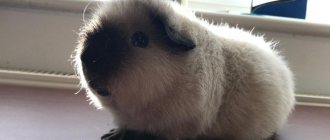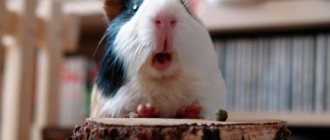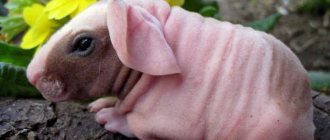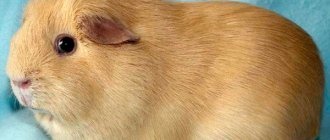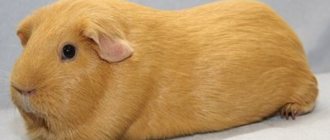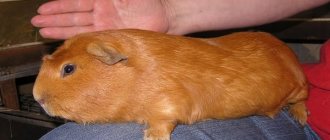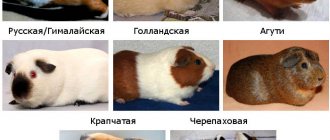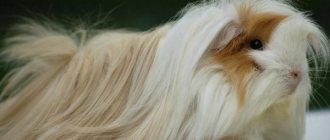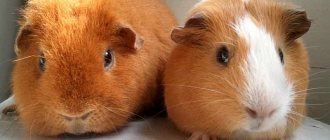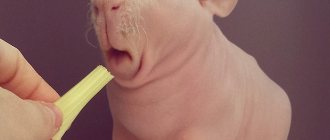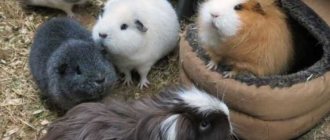The guinea pig has nothing to do with the sea; it doesn’t even really know how to swim. At first it was called overseas, but over time the name was replaced by a more modern one. Comes from South America. In our area, it can be considered an almost ideal pet. He is not capricious, requires minimal attention, eats little. Before purchasing a guinea pig, it is important to find out the price in your area. It can vary several times.
The cost of a guinea pig depends on the following factors:
- Breed;
- Age;
- Appearance and condition;
- Place of purchase, from hand or in a pet store;
- Region.
You can buy a guinea pig at most pet stores. Due to its small size, it does not interfere at all at home. The price of a pig in pet stores is 100–7000 rubles. But you can find it for free, just search the Internet on free classifieds sites. Often someone wants to give animals into good hands, but does not ask for anything in return.
The beauty of guinea pigs
According to many owners, the small guinea pig is practically devoid of shortcomings as such, although this animal is not for everyone. The main advantages include:
- Complete absence of aggression;
- Peace of mind at any time;
- Doesn't need a big house;
- Unpretentious;
- Doesn't bite;
- With proper care it does not leave odors;
- It is easily tamed and loves human affection and attention.
They reproduce easily, which breeders do not neglect. Guinea pigs are primarily kept as pets, but are also used for food. To date, more than 50 different breeds have been bred, each of which can be purchased. Due to the popularity of guinea pigs, owners hold many exhibitions and even seminars. Animals are ready to reproduce already in the second month of life. Thanks to their special friendliness, children love them very much.
How to keep a guinea pig
Keeping a guinea pig is very simple and everything it needs is cheap. She does not need a large terrarium or cage, does not make unnecessary sounds, is unpretentious to food and is easy to keep. To ensure a comfortable stay in your home, it is enough to provide the basic needs:
- The high tray of the cage will protect the guinea pig from the wind and the room from debris.
- Sennik must be mandatory.
- A running wheel can be installed upon request.
- It is recommended to change the litter regularly.
- It is advisable to feed your guinea pig under supervision so that leftover food is removed in a timely manner. This is done so that it does not spoil, since products with signs of spoilage and mold are harmful to the animal.
- The drinker must be ball-shaped.
- Teeth grow throughout life, through which the animal experiences a constant need to grind them down. To do this, tree branches are placed in the cage.
When looking for the perfect pet, people often have to choose between her and a hamster. As a rule, both are bought for children. But the pig has one significant advantage: 10-20 minutes several times a day are enough for her to sleep. At the same time, the hamster is almost completely nocturnal and sleeps all day.
Skinny
These pigs of truly exotic appearance appeared as a result of a mutation in 1978 at the Institute of Montreal (Canada). They have no fur, only on the nose and paws there are sparse curly and coarse hairs. Skinny skin is very soft and velvety. The most common color is chocolate; there are black, tortoiseshell, silver, lilac, etc.
Skinnies have an excellent appetite, which is not surprising: they have a faster metabolism, as they need to retain body heat. Therefore, they eat 3 times more than their furry counterparts, sometimes gnawing on something all day long.
Due to their lack of fur, skinnies require a little more care and attention than regular guinea pigs. The main thing that future owners of these cute and gentle creatures need to know is that skinnies need to be protected from drafts and always kept warm. If fasting days are only beneficial for most animals, then for skinnies to remain for two days without food is literally like death. At the same time, skinnies are prone to obesity, so the owner’s task is to carefully consider the diet, establish a diet and strictly adhere to it.
Baldwins
Unlike Skinnies, who have tufts of hair on their paws and nose, Baldwins are a completely hairless breed. Babies are born covered with fur, like ordinary pigs, but by the age of one month it completely falls out. Baldwins have extremely delicate skin; both cold and direct sunlight are dangerous for it.
A person who has decided to get a guinea pig and has become acquainted with all the variety of breeds faces a difficult question: how to choose “your breed” among all this diversity?
Surely, many people want to have a rare breed of pig at home. Thus, hairless guinea pigs are very in demand and popular today. But here you need to take into account that these are more delicate and sensitive animals, they are more demanding in terms of care and living conditions. And the price for such exotics will be significantly higher than for pigs of less rare breeds. In addition, when purchasing a pig of a rare breed with a good pedigree, additional responsibility is imposed on the owner: you need to join a club, take part in exhibitions, find your pet the most suitable partner for mating, etc.
Pigs of less rare breeds can be no less beautiful and affectionate pets.
Short-haired guinea pigs are easier to care for, they have high immunity, which means they get sick much less often than other breeds of pigs. Animals with short hair are the best choice for a novice breeder. In addition, if you are purchasing a guinea pig for a child, it is best to choose just such a pet. Caring for rosette pigs is also not very difficult, but they are somewhat more expensive. As for guinea pigs of long-haired breeds, they need more thorough coat care, which will require much more time. Share with your friends:
At what age should you buy a guinea pig?
It is best to buy a young guinea pig; the cost at a pet store will be higher, but you can get one from your own hands. At a young age, they will bring maximum positive emotions, and they will grow right before our eyes, along with the children. The older you buy, the cheaper it will be, but it will also last less.
For normal growth and development, the pig is fed hay, vegetables, fruits and herbs. They love salads made from vegetables and herbs. Make sure that the diet contains twig food. It is recommended to feed roughage; you can buy special compound feed, or wheat and oats, at a pet store. Your daily diet should contain sufficient amounts of vitamins and minerals. In winter, the body especially needs vitamin C. The average life expectancy at home reaches 5 years, with good care even longer.
We will consider the cost of a guinea pig using the example of two breeds, common and rare.
Subspecies of giant pigs
Creole
A characteristic feature is a massive forehead, muzzle and body are somewhat elongated. The development of pigs is slow, more or less formed by two years. This species is more common in Europe, but has difficulties in breeding due to its temperament and nervousness.
Meat Cuis from Peru
The animal has a strong skeleton, a characteristic feature is wide and drooping ears or, conversely, very shortened ones. The rodent has strong paws and a wider head than other subspecies. They gain weight easily, and at 6 months the baby has the size of a large individual. The character is calm and friendly.
Pigs from Peru are divided into 4 subspecies:
- English - the coat can be of various colors, smooth and short. They gain weight quickly, because... not complicated in content. This subspecies is the most common.
- Abyssinian - colors can also vary, the coat is predominantly short. They are fastidious in keeping, mix with other species, and their physical development is longer than that of other subspecies.
- Peruvian - long coat. The individual is distinguished from other species by its elongated body. They are bred for decorative purposes. The animal is prone to diseases and produces small litters.
- Merino has a distinctive curly wool. The animal has a small round body. Fans of exotic meat compare their meat with bacon and recognize it as the most delicious.
Representatives of the Kui breed have a difficult character - they are distrustful of people, sometimes timid and wild. Females, unlike males, are aggressive towards other individuals.
To tame an animal, you will have to put in a lot of effort, and taming is often unsuccessful. The average life expectancy is 3-4 years, they are prone to aging quickly, but in good living conditions they can live up to 6 years. They ripen quite early, mating for reproduction begins at 4 months.
European breeders are working on developing new species - they have created the Cobayo breed, which reaches truly large sizes - 4 kg and 50 cm in length.
In fact, keeping Kuya is not particularly different from other rodents; the main emphasis should be on the choice of cage, given that this breed is large in size. Females do not like loneliness, but at the same time they do not like neighbors and even start fights. Males fight for territory only with a potential rival. Therefore, a home for a pet must be selected taking into account the characteristics of the breed.
Angora guinea pig - how much does it cost?
One of the most common breeds is the Angora; in a pet store such a pig costs 1000–2000 rubles. The price depends very much on the region. If the owner sells the animal, you can take it for 500–1000 rubles.
The cost of guinea pigs depends on age. When purchasing, pay special attention to this factor. If the price is too low, the animal may be elderly or sick. The Angora guinea pig has gained such high popularity due to its attractive long fur.
Bald skinny guinea pig – price
The skinny guinea pig is a rare breed and is therefore much more expensive. Its uniqueness lies in the fact that before the age of one month it completely goes bald. In some places they are very rare, the cost can go up significantly. As a rule, a skinny pig costs between 3-4 thousand rubles.
When choosing this breed, be very careful, it requires special care. Wool is completely absent, due to which external factors have a serious impact on the body.
Abyssinian (rosette) guinea pigs
The Abyssinian breed is one of the most popular. Abyssinians first appeared in England in 1861 as a result of a mutation in the coat gene, and in 1866 the first individuals were brought to Europe.
A characteristic feature of the Abyssinian breed is a special growth of hair, which is why rosettes are formed (the hair in the rosettes diverges from the center to the periphery). Rosettes must be of the correct shape and have clear boundaries. The total number of sockets is 8-10, maximum 12. The standard specifies their location: 2 on the nose, 1-2 on the shoulders, 4 on the sides and 4 on the back of the body. In addition, they must be symmetrical. In some individuals, as a result of mutation, the number of rosettes can reach 30 pieces - these are no longer considered purebred. The rosettes located nearby form tufts, or ridges. Any colors are possible. The fur reaches 3-4 cm in length; in females it is softer than in males. The body of Abyssinian pigs is strong, muscular, and moderately long. The shoulders and chest are wide, the back is straight, the back is rounded. The legs are straight and short. The head is short, rounded, with large ears, large shiny eyes and a slightly elongated nose (this is called a Roman nose).
Pigs are distinguished by their unpretentiousness and goodwill towards humans. In the vast majority of cases, Abyssinians quickly get used to being handled and get along well with children. Among the disadvantages, one can note the extraordinary gluttony, so the owner needs to be extremely attentive to the amount of food in his pet’s bowl so as not to overfeed him. Due to excessive consumption of food, pigs suffer from obesity and heart disease.
Breeding quality
There is such a thing as “breeding quality.” It concerns breeds and specific individuals intended for exhibitions. Conventionally divided into 3 classes:
- Show class - maximum compliance with the breed standard. Purebred representatives of the species. How much such a guinea pig costs depends on the severity of the breed of each individual. In most cases, it is this class that wins at exhibitions. The cost is very high, since few people agree to sell them. It takes a lot of effort and time to raise a purebred animal.
- Breed class - there is a slight deviation from accepted standards. Changes may be expressed in color or other features. Not suitable for exhibitions, but capable of producing show class offspring. Used for breeding.
- Pet class - a completely healthy individual, but with congenital or acquired defects. Not intended for exhibitions or breeding. Usually bought as a pet.
If you need an animal for an exhibition, the cost greatly depends on the class. In general, a guinea pig can cost from 500 to 5 thousand rubles or more.
